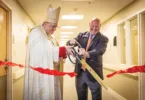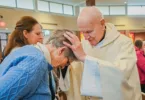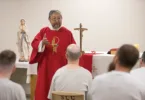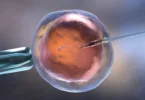by Wooden Koenig-Bricker
Catholics the world over will be attending services this Holy Thursday, Good Friday or Holy Saturday without ever realizing an important fact: All three liturgies are most properly viewed as one continuing celebration of faith.
In fact, the Triduum services do not end with “Go forth, the Mass is ended” until the conclusion of the Easter Vigil on Saturday evening.
That’s because the paschal mystery — the life, death, burial and resurrection of Christ — is not to be viewed as a sequence of events, but rather as the story of our salvation history. What is left incomplete on Holy Thursday or Good Friday is continued in the next day’s liturgy, until all is fulfilled at the Easter Vigil.
Holy Week, of course, starts with Palm Sunday of the Passion of the Lord, when Christians celebrate the triumphal entry of Jesus into Jerusalem.
But the Triduum (the “Three Days”), which starts on Holy Thursday, is measured in the Jewish fashion — from sundown on Thursday to sundown on Easter Sunday, when evening prayer completes the Triduum.
During those days, many of the rites and rituals of our faith were established.
Holy Thursday
The Mass of the Lord’s Supper on Holy Thursday not only marks the institution of the Eucharist at the Last Supper, but also what is called the mandatum — the new commandment of the Lord to his disciples to love one another (Jn 13: 34-35). This is symbolized in the Holy Thursday service by the washing of the feet of members of the congregation by the celebrant of the Mass.
This is so critical a part of the liturgy that the pope himself participates in it, washing the feet of 12 priests representing the apostles.
At the end of Mass, the altar is stripped, and the Blessed Sacrament is taken to a special altar of repose, where the faithful are invited to spend time with Lord, keeping vigil as did the disciples in the Garden of Gethsemane. Crosses that can be removed are removed, and those remaining are covered, so that the cross used for veneration on Good Friday will be the focal point.
Good Friday
The only day of the year on which Mass is not celebrated, Good Friday commemorates the passion and death of Our Lord. There are three unique aspects to this service.
The first occurs during the Liturgy of the Word, in which the Passion according to St. John is read, followed by a series of ten solemn intercessions, praying for the church, the unity of Christians, the Jewish people, those who do not believe in Christ or God, those in public office and those in tribulation.
The veneration of the cross follows. A veiled cross is carried in solemn procession from the entrance of the church and is uncovered in three stages, each beginning with the priest intoning, “Behold the wood of the Cross, on which hung the salvation of the world.” Members of the congregation are invited to come forward and reverence the cross in some fashion — either by bowing or genuflecting, kissing the wood of the cross or the feet of the corpus, or in some other way venerating it.
At the conclusion of the veneration, holy Communion, which was consecrated at the Holy Thursday Mass and kept in reserve, is distributed.
The priest and people then leave the church in silence. In addition, the Stations of the Cross or other devotions are often celebrated later on Good Friday.
Holy Saturday
The celebration of the Easter Vigil Mass is the high point of the liturgical year, combining the Service of Light, the Liturgy of the Word, the Liturgy of Baptism and the Liturgy of the Eucharist.
The vigil begins after dark and, if possible, outdoors. There, the celebrant draws from a newly kindled fire the flame to light the paschal candle. The lit candle is then carried into the church, where each member of the congregation holds his or her own smaller candle. Their candles are then lit from the paschal candle as it is carried in procession, as the priest or deacon sings three times, “The “Light of Christ.” Soon light spreads throughout the darkened church. The Easter Proclamation, called the
“Exultet,” is then sung.
The Liturgy of the Word follows. The Easter Vigil features from three to seven Old Testament readings, which trace the history of salvation, a reading from the New Testament and, finally, a Gospel reading.
Following the homily, those who will be entering the church — the catechumens and candidates — are baptized or make a profession of faith in the Catholic Church. Then these new Catholics receive the sacrament of confirmation. The rest of the community then renews its baptismal promises as the celebrant sprinkles all with newly blessed holy water. The Mass then continues as usual, with the new members of the church receiving their first Communion.
On Easter morning, Masses are said throughout the day and, for the entire next week, the church celebrates Easter “morning” at its daily Masses.
This is known as the Octave of Easter.
Even if a Catholic can’t make it to every liturgy of the Triduum, participating in at least some of the rituals of these solemn holy days joins him or her to the universal church in a unique way. Participation in each service of the Three Days, however, can’t help but lead to a greater appreciation of the sacrifice of Our Lord as commemorated in this summit of the church’s liturgical tradition.






